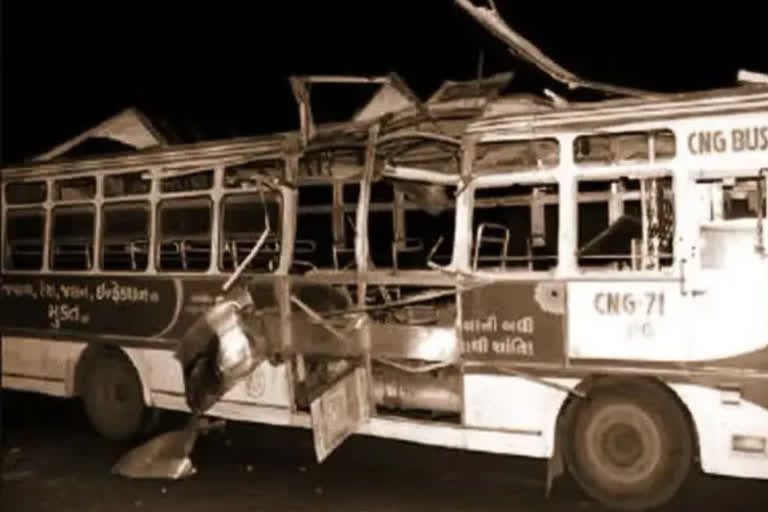Ahmedabad:Marking the end of a historic trial that lasted for more than 13 years, Special Court judge A R Patel on Friday sentenced 32 accused to death and 11 to life imprisonment in the 2008 Ahmedabad serial bomb blast case. Being the first verdict that pronounced a mass death-penalty, the case will also go down in history as one of the most prolix cases with around 51 lakh pages of chargesheets and over 6,000 documents submitted as evidence. With over 78 persons tried and 1,171 witnesses presented across the entire hearing, the case dealt with the series of 22 bomb blasts executed in Ahmedabad in 2008.
On July 26, 2008, in the span of about 70 minutes, 22 bombs went off at various places in Gujarat's Ahmedabad, including at the Ahmedabad Civil Hospital, LG Hospital, in buses, on parked bicycles, and in cars across different locations in the city. Though two bombs — planted in Kalol and Naroda — did not go off, the overall attack took the lives of fifty-six people, injuring 246 more. Ahmedabad was the third city to be bombed that year, after Jaipur in May and Bengaluru. In emails that were sent to some media houses, the Indian Mujahideen (IM), an organization that had not been heard of until then, had claimed responsibility for the attacks. The very next day, on July 27, similar bombs were found in Surat too, none of which, however, went off.
The Timeline
- July 26, 2008:20 blasts stir Ahmedabad, killing 56 and injuring 246. Just ahead of the blasts, the media receives an email saying 'stop us if you can'.
- July 29, 2008:Bombs found and defused in Surat.
- August 16, 2008:Gujarat police arrest 10 people, term Mufti Abu Bashar the mastermind.
- February 15, 2010: Court frames charges against 64 accused, SC stays trial.
- July 6, 2011:SC lifts stay on proceedings.
- July 2, 2012: Trial resumes, first witness examined.
- February 11, 2013: Sabarmati Jail authorities finds a 213 feet tunnel in the prison.
- May 18, 2013:24 serial blast accused get charged for prison break bid through the tunnel.
- August 31, 2021: Final arguments conclude, court reserves its verdict.
- February 8, 2022:The Special Judge declares 49 of the total 78 accused as guilty under various offences of the Indian Penal Code, including murder, sedition and waging war against the state, as well as under offences of the UAPA, Explosive Substances Act.
- February 18, 2022:A special court designated for the speedy trial of the 2008 Ahmedabad serial bomb blasts case sentences 38 of the 49 convicts to death under provisions of the Unlawful Activities (Prevention) Act (UAPA) and Section 302 of the Indian Penal Code. The 11 others were sentenced to life in jail till death.
The Modus Operandi
The emails purportedly sent out by the Indian Mujahideen to the media houses immediately after the blasts contained images from the Gujarat riots of 2002, and claimed the bombings were revenge for the riots and for the destruction of the Babri Masjid in Ayodhya in 1992. This was the first clue that led the officials into further unravelling. The Gujarat police and the Intelligence Bureau, along with cooperation from police authorities from Rajasthan, Delhi, Madhya Pradesh, Maharashtra and Karnataka, probed the matter across multiple cities, with the use of ANFO, a widely used industrial explosive, and the IM’s claim of responsibility being the common thread.
The very first clue that led to the further unveiling was one of the cars used in the blast with fake registration. Post the investigations conducted in Baroda on this basis, some of the culprits were identified and arrested. Interestingly, the investigations not only led to pin-pointing of real terrorists behind the bombing but also led to cracking up of the entire Azamgarh, Delhi, Mumbai and Bhatkal modules of the group which had the support of jihadist groups across the border.
It was found that the Ahmedabad IEDs were assembled by the Azamgarh module of Indian Mujahideen, while the Surat IEDs, which fortunately did not explode, were made by Riyaz and Iqbal Bhatkal group. The ammonium nitrate explosive was sourced from Karnataka with the jihadists brainwashed by ex-SIMI leaders like Safdar Nagori and Sarai Meer Mufti Abu Bashir. The case was solved after Mufti Abu Bashir was picked up by the Gujarat Police and Intelligence Bureau from Sarai Meer on August 16, 2008.
Forensic analysis at the blast sites revealed ammonium nitrate and fuel oil as the primary components of the improvised explosive devices. The bombs were reportedly placed in cars stolen from Pune and Mumbai, gas cylinders were kept in the cars, and the bombs were improvised with ball bearings. It was similar to devices used in other sites of India, but ones used here were refined for deadly precision.
About the Terrorists
